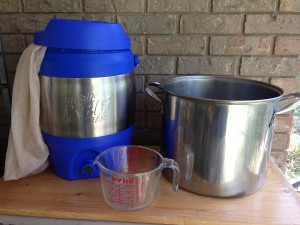I’m a big fan of partial mashing. For all-grain brewers who usually brew outside, it allows you to get out of the elements during inclement weather and brew in your kitchen. For extract brewers, there are a host of benefits.
Adding base malts to your extract recipes increases the aroma of base malt, which is sometimes lacking in malt extracts. And, it allows you to use the many different kinds of base malts out there and base malts made by different maltsters. More ingredients to choose from gives you the opportunity to more finely tweak the flavor of your beers.
A partial mash also allows you brew a lighter-colored beer, compared to the extract-plus-steeping-grains method, if you want to. In addition, if you’re trying to make a dry beer, you can use the enzymes from the partial mash to raise the fermentability of your wort. Finally, you can add small amounts of starchy adjuncts to your beer, without having it turn hazy. Starchy adjuncts include flaked (or torrified) unmalted grains such as flaked maize, flaked barley, flaked wheat, torrified wheat, rolled oats, etc. [The weight of the starchy adjuncts should be 30% or less of the total weight of the grains, excluding any malt extract, and paired with a lightly-kilned base malt with plenty of diastatic power (enzymes to convert starches) such as US 2-row pale malt or US 6-row pale malt.]
A small partial mash can be accomplished almost exactly as you would brew an extract recipe with steeping grains. The only procedural difference is you need to watch the temperature more closely and not “steep” the grains in too much water. It’s hard to think of any drawbacks to the method, although you might generate slightly more break material in your brewpot.


Recent Comments